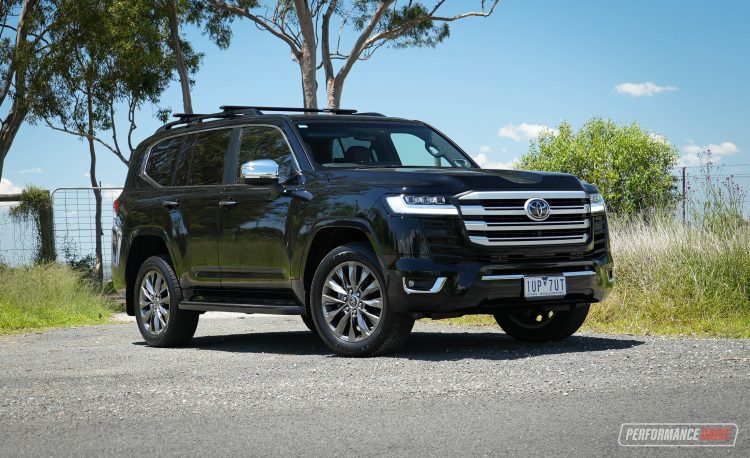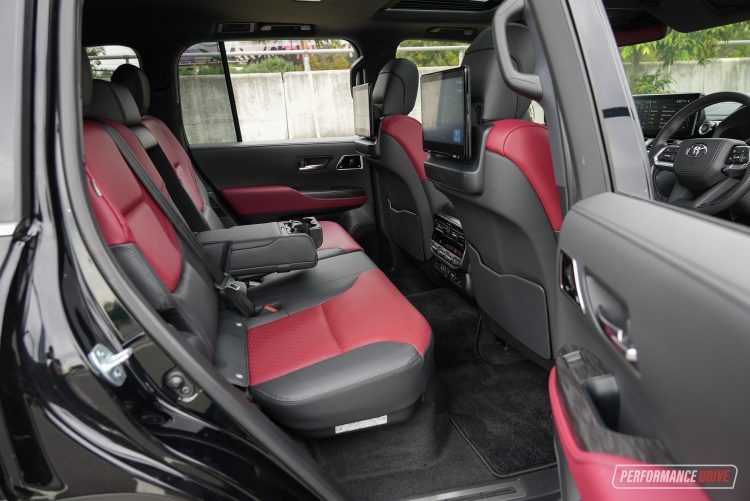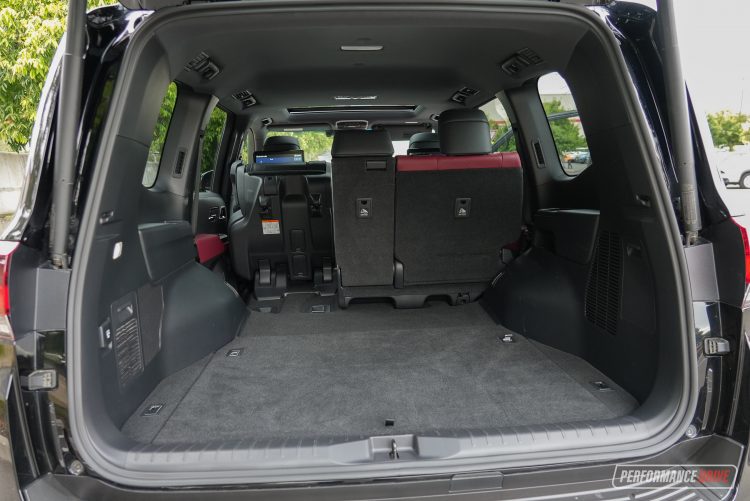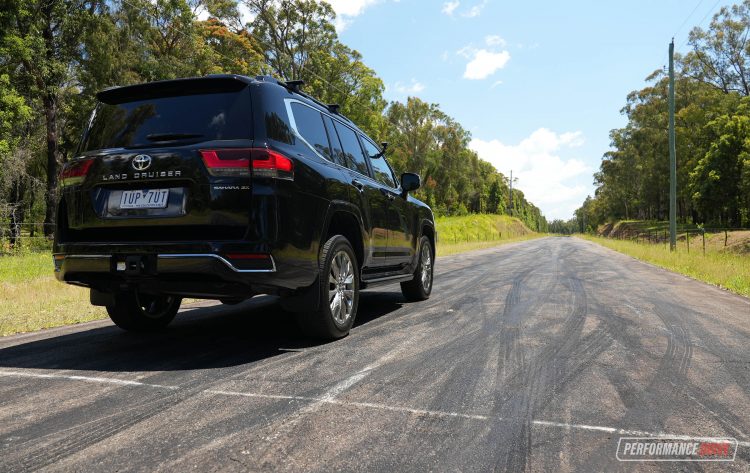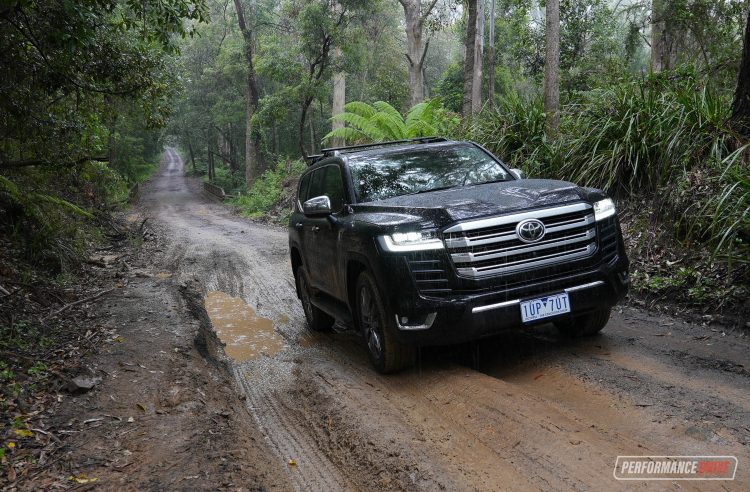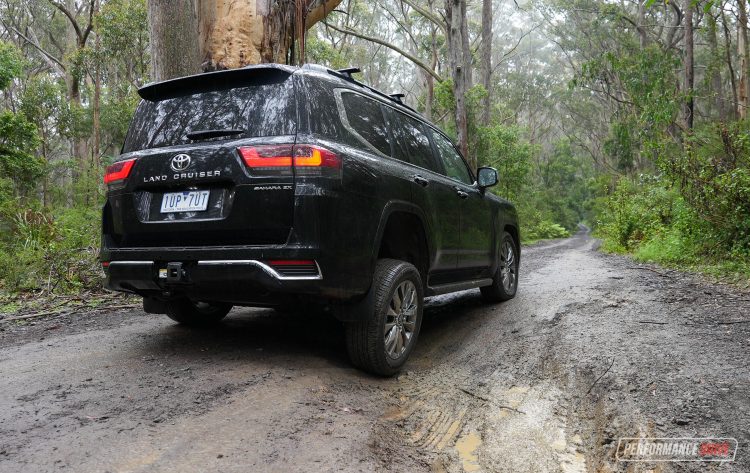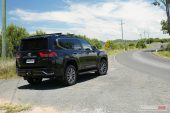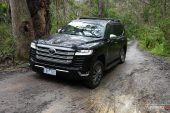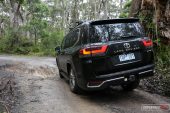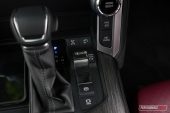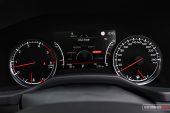Yes, it’s been one of the most highly-anticipated vehicles of the last five years or so. And now it is finally here. The mighty 2022 Toyota LandCruiser 300 Series.
When we say it is finally ‘here’ we should really say it is now available, but not necessarily here. Because, at the time of writing, there is a waiting list of at least six months for these things. At least. Through our parent company and its OnlineAuto brand and national dealer network, we’ve heard there are some demo models at dealerships but these are apparently not allowed to be sold until at least June, 2022.
We’ve heard that if you order one now, you are likely to wait until at least then before it arrives. And that’s if you want a common variant and colour combination and so on. If you want to custom-order and pick and choose some of the less popular paint options, you might be waiting until next Christmas.
Toyota has said there were production stops at its plants in Japan in August and September, largely due to the coronavirus pandemic and follow-on implications (such as chip and supply shortages). But Toyota Australia has been notified by HQ and passed on the message that production is scheduled to be back in full-swing in December. So by the time all of the back-orders are filled, who knows.
Anyway, we’re not here to review delivery times. We’re here to review this iconic, land-conquering machine. And it’s a huge deal. Not just physically but also figuratively. It is an all-new generation LandCruiser. This only happens every decade or so.
Toyota Australia offers six main variants, spanning from the GX, GXL, VX, Sahara, GR Sport, and Sahara ZX. All versions in Australia are powered by the company’s all-new ‘F33A-FTV’ 3.3-litre twin-turbo diesel V6 engine, producing 227kW and 700Nm. For this review we’re specifically looking at the top Sahara ZX. We are aiming to review other variants when we can.
2022 Toyota LandCruiser Sahara ZX – THE SPECS
[column width=”47%” padding=”6%”]Engine: 3.3-litre twin-turbo V6 diesel
Output: 227kW@4000rpm / 700Nm@1600-2600rpm
Transmission: 10-speed auto
Drive type: Four-wheel drive, centre diff lock, rear LSD
Wheels: F & R: 20×8.0, 265/55
ANCAP: Five stars
Tare weight: 2525kg
Power-to-weight: 11.12:1 (kg:kW)
Official fuel economy: 8.9L/100km
Economy during test: 12L/100km[/column] [column width=”47%” padding=”0″]Fuel capacity/Type: 110L/Diesel
Power efficiency: 25.50kW:L/100km
0-60km/h: 3.47 seconds*
0-100km/h: 7.61 seconds*
60-110km/h: 5.38 seconds*
1/4 mile: 15.49 seconds at 145.7km/h*
Max acceleration: 0.766g
100-0km/h braking: 3.42 seconds at 40.60 metres*
Max deceleration: -1.122g
Decibel at idle: 47*
Peak decibel at 60-100km/h: 80*
Priced from: $138,790[/column][end_columns]
* Figures as tested by PerformanceDrive on the day. Factory claims may be different
2022 Toyota LandCruiser Sahara ZX – THE PACKAGE
Inside, this Sahara ZX could easily be mistaken for a Lexus. It is really lavish in here, and a drastic upgrade over the predecessor. There’s a huge touch-screen (12.3-inch) on the dash filled with plenty of apps and gadgets, including Android Auto and Apple CarPlay, external camera views, off-road settings, and the usual stuff like sat-nav and digital radio.
The ZX also features a 14-speaker sound system by JBL, shared with Sahara, head-up display, and ‘advanced carbon’ trimmings for the dash, console, and steering wheel. The arrangement of switchgear is showcased in a brushed aluminium-like finish, really helping to bring the big beast into the next-generation.
As usual, cabin space is not likely to be an issue for most people. It is massive in here. Check out the size of the centre console, for instance. Passenger comfort is also outstanding, with big cushy seats and power adjustment in the front, heating and cooling functions for the front and rear seats, and even the carpet mats feel thick and plush.
Rear seat space is exceptional, and there’s now a large control console with temperature settings, charging ports, and this example shows off a pair of touch-screens on the backs of the front seats. These screens can play from various sources and there are headphone jacks, but it is very confusing to set it all up. We couldn’t figure out how to stream from services such as YouTube or Neflix either, which you can easily do from a handheld tablet or iPad.
Rear passengers get climate vents in the ceiling as well as in the usual spot in the middle, and it seems Toyota has carved out some space in the floor to help open up legroom. In the 200 Series the floor always seemed quite high, obviously to maximum ground clearance. But now it doesn’t feel like you’re sitting on the floor.
Being a five-seater, the ZX, means the boot is just humongous. It’s tall, deep, and very wide, offering a whopping 1131 litres or up to 2052L with the rear seats folded and flipped up out of the way. There’s also an Aussie power socket in the boot wall, and some plastic-lined under-floor storage ideal for wet or loose items. A full-size spare wheel remains under the vehicle at the back.
2022 Toyota LandCruiser Sahara ZX – THE DRIVE
We know a lot of traditional fans and existing 200 Series owners have been concerned about the new V6. Or perhaps more accurately, disappointed to see the V8 is no longer available. So let’s dig in and compare some of the facts and figures with the outgoing 4.5 twin-turbo V8 diesel.
This new 3.3 produces 227kW at 4000rpm, and 700Nm between 1600-2600rpm. The 4.5 V8 developed 200kW at 3600rpm and 650Nm between the same 1600-2600rpm rev range. You can’t really pick that apart any further. It’s simply a win for the new V6; more power and more torque, with virtually identical accessibility.
Next up, the performance. In this Sahara ZX we clocked 0-100km/h in a best of 7.61 seconds. The last 200 Series we tested achieved the sprint 9.08 seconds. That’s on the exact-same piece of tarmac with the same driver and the same Racelogic Vbox Sport GPS data-logger. Again, a win for the new V6. A big win, too.
The other important factor is fuel consumption and emissions. This new unit offers an official average consumption of 8.9L/100km while the old Sahara 4.5 V8 was rated at 9.5L/100km. That’s under the same Australian Design Rules protocol. For the combined emissions output, the new V6 is rated at 235g/km and the old V8 diesel was rated 250g/km. So that’s another decent win for the new V6.
It’s all looking very promising for the new model’s engine. About the only on-paper deficit we can find is the theoretical average range. Because this new model features a 110-litre fuel tank, the range is smaller than the old model. In the old Sahara with its 138L tank you had a theoretical range of 1453km, while this Sahara ZX calculates at 1236km (the same across all 300 Series variants in Australia).
That’s going to be a fairly serious issue for some buyers, perhaps. Especially those that live in remote areas or regular travel to and from remote areas. However, this is all based on the official average consumption and real-world experiences are likely to be quite different, either direction, depending on your driving style and the conditions.
Speaking of personal experiences, we saw an average consumption of around 12L/100km during our week of driving. That included a decent highway trip from Sydney to Wollongong and back, some light off-roading in the mud, and our usual run of performance tests. The last 200 Series we tested – a 2019 VX – under very similar conditions, we recorded an average of 13L/100km.
In terms of the refinement and noise levels, this V6 idles at 47dB and peaks at 80dB during full-throttle acceleration between 60-110km/h. That doesn’t compare that well against the old 4.5 V8, which recorded 47dB and 74dB, respectively. Again, that’s according to our tests, with the same decibel gauge and in the same testing location.
That’s not necessarily a bad thing, though. In our opinion this new V6 does produce a more refined note. And that off-putting cooling fan noise during initial take off is gone. From behind the wheel you can’t hear much evidence that this is even a diesel engine. There’s very little clatter and only in very specific lower ends of the rev range, and mainly when it’s cold. But then up higher it gives off a nice whooshing thrum. It’s quite soothing.
For us the main benefit of this new engine… well, the benefit we enjoy the most, is the massive torque and strong acceleration. To be honest we were very surprised to see the 0-100 dash done in just 7.61 seconds. That’s a very respectable time, even for a sports car – we’ve seen similar results in the outgoing Toyota 86, for example.
Out on the road the engine feels a lot more willing than the old V8. It’s like this new model is always in a ‘sport’ mode. Actually, that could get annoying as the throttle would be too touchy. But it does feel much more responsive and lively. The old model required you to select the ‘PWR’ mode, whereas this almost feels like it is selected by default when you start the engine.
The new 10-speed auto works well to sync up with engine’s ideal speeds, so it’s always ready to go. It cruises wonderfully, too, requiring just 1200rpm to maintain motorway speeds. And then if you approach a long steep hill, that monster 700Nm barges in like a giant wall, effortlessly pushing you along. In fact, the revs hardly change at all during such scenarios and it often doesn’t even need to change down a gear. Overtaking is also a less nervous task.
Being based on a new ladder-type chassis (TNGA-F), with a live-axle rear end, it is not the most sophisticated in the handling department. There is definitely some lean going into and around corners, and mild understeer and tyre moan when you ask it to hustle through. The steering is nice though and conveys all of the information you need or expect from a vehicle of this stature.
Going with the Sahara ZX gains access to adaptive variable suspension so you can hit the Sport mode or Sport+ mode to help tie the vehicle down somewhat. It does help, but it can’t mask the fact this has a tare weight of 2525kg, while incorporating a flexible suspension system that has to offer a long compression and extension travel off road.
Of course, this has to work in demanding off-road conditions and you could argue that on-road performance has to be sacrificed as a result, regardless. And yes that is totally correct in this case. The 300 Series is still an unstoppable beast when the going gets rough. Mind you, the Sahara ZX is not the ideal variant if you are regularly venturing in such settings, as the bespoke front bumper reduces the approach angle compared with other variants.
According to Redbook specs, this variant offers an approach angle of 24 degrees (32 degrees for other variants) and a 25-degree departure angle. Compared with the old Sahara, the figures were 32 degrees and 24 degrees.
Engineers have obviously worked hard to ensure the underbody is a flat as possible, improving not just off-road clearance but also on-road aerodynamics. Ground clearance is rated at 245mm on this variant, which is up 15mm compared with the old Sahara. This is according to Redbook stats (which have been wrong lately with some stuff). Toyota Australia’s official press kit says all 300 Series variants offer a ground clearance of 235mm.
Across a rutted dirt road, in the wet, this example showed absolutely no sign of struggle or hesitation. Even through a sharp water-carved rut the suspension offered plenty of flex and wheel travel to keep the tyres on the ground. The ZX does come with a centre diff lock, a limited-slip rear differential, and a dual-range gearbox to get you through really tricky terrain. Again, if you want outright off-road capability you should check out the GR Sport or the GX. The GR Sport comes with front, centre, and rear diff locks.
2022 Toyota LandCruiser Sahara ZX – THE VIDEO
2022 Toyota LandCruiser Sahara ZX – THE VERDICT
The great thing about the 300 Series, we think, is that it is not a distant evolution from the 200 Series. It looks pretty similar and offers very similar off-road capability (perhaps even greater), durable ruggedness, and all wrapped up in a huge, family-friendly package.
The top Sahara ZX goes further by offering Lexus-like luxury and appointments, with lots of quality details inside and loads and loads of functions and features. Yes, it is pricey but it genuinely feels like a large premium SUV, and offers similarly high-tech features. And yet the price does come in well short of a top-spec premium rival.
What we truly adore the most though is this new V6 diesel engine. It offers bucket-loads of torque and really impressive performance for this size/weight of vehicle. Outright refinement, including noise and vibrations and diesel clatter, are massively improved over the old 4.5 V8 diesel as well. It helps the new model become an even better, more effortless grand tourer. Hey, Toyota, can we please take one around Australia?
[column width=”47%” padding=”6%”]PROS:
– Beaut new 3.3 V6 diesel; more power and torque, quicker, more efficient than old 4.5 V8
– Interior is much more up-market, Sahara ZX is quite Lexus-like
– Family-friendly packaging, ZX comes with everything
– Still a properly rugged off-roader underneath with real off-road capability
– Legendary Australia-conquering reputation
[/column] [column width=”47%” padding=”0″]CONS:
– Theoretical range drops from 1453km to 1236km, now 110L fuel tank (from 138L)
– Design doesn’t immediately shout 2022
– Price has jumped more than others during their natural evolution
– Long delivery delays[/column][end_columns]
As always, if you’re thinking about buying a new car don’t forget to click here to speak with our car buying specialists.
